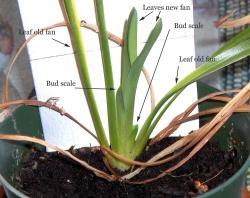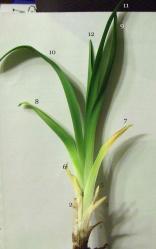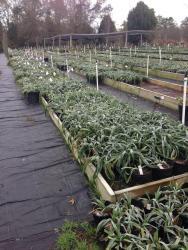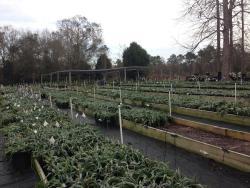chalyse said: So, do I understand it right that this bud dormancy (paradormancy) is the crux of what we mean when we say a cultivar is dormant, semi, or evergreen? Or, are you exploring the idea that those three descriptors are not really capturing all the variations that could be given to each cultivar (it would be neat if there were more levels to how a cultivar is described, so that growers could know how the plant will perform), and that it might also be possible to add hard-freeze and drought/high temp performance as standard info on cultivars as well?"
The three descriptors dormant/evergreen/semi-evergreen are not capturing all the variations that could be used to describe each cultivar - the biological information. There is more to it.
Dormant means the plant part is not growing. If one wanted to describe a plant as dormant then a plant that was not dormant would be described as non-dormant or possibly evergrowing but it would not be correctly described as evergreen (or semi-evergreen). Dormant applies to growth or not growing.
Evergreen is a description of the leaves. It tends to mean that the plant keeps its leaves in cold winters. If a plant is described as evergreen then a plant that is not evergreen would be described as decidous not as dormant. Deciduous is a description of the leaves. It means the plant loses its leaves in cold winters.
But neither evergreen nor deciduous really describes daylily leaves well. Daylilies do not have real evergreen leaves because evergreen leaves should last more than one year and daylilies do not drop their leaves the way a deciduous tree does. More correct terms for daylily leaves would be winter-green meaning that the leaves survive one winter or summer-green meaning that the leaves survive for only one growing season.
None of these terms, dormant versus evergrowing for the growth characteristic or winter-green versus summer-green for the foliage characteristic is related to cold hardiness.
Within the category dormant a daylily could be winter dormant or summer dormant or both (or they might be the same thing - we do not know). Within the winter dormant category a daylily could be endodormant or ecodormant. A daylily that was summer dormant could be ecodormant, endodormant or paradormant.
All the complications/categories above would describe the biology of daylilies.
The categories dormant/evergreen/semi-evergreen are registration categories - they do not relate well to the biology of the daylily - the biology is far more complicated.
Daylilies can be paradormant (during the summer). They can be winter ecodormant. They can be summer ecodormant. The same daylily cultivar that is summer paradormant one year could be summer ecodormant in another year or not summer dormant at all in another year.
I am trying to find out if any daylilies are winter endodormant. So far it seems that if there are any endodormant daylilies there are not very many at all left in the modern cultivars.




. The ones that were bursting out of the pots (I had to cut the pots off of them) I went ahead and planted in the ground. And at the other end of this bed I planted in the ground some of the "we will watch another year" seedlings. These are not all of the seedlings, these are just Kim's I have another 300 of mine I have to figure out where to put.
